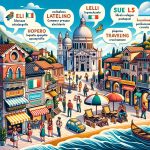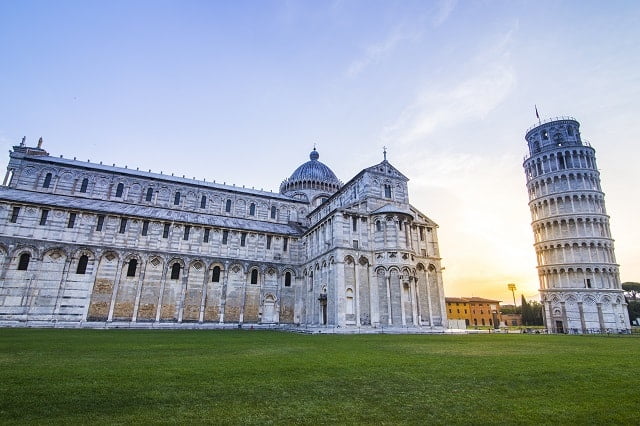Are you planning a trip to Italy and need to know the basics for Italian travel? Whether you are a first-time visitor or a seasoned traveler, this guide will provide essential information to make your Italian vacation memorable and hassle-free.
Italy is renowned for its rich history, art, culture, and cuisine, making it a popular destination for travelers from around the world. In this introductory section, we will provide an overview of what to expect when traveling in Italy, including language tips, dining etiquette, transportation options, accommodations, must-see landmarks, packing tips, and safety and cultural etiquette.
From the charming canals of Venice to the ancient ruins of Rome and the picturesque landscapes of Tuscany, Italy has something to offer every traveler. So grab your passport and get ready to explore the wonders of Italy with our comprehensive guide to Italian travel basics.
Whether you’re dreaming of sipping espresso in a sidewalk cafe or marveling at masterpieces in world-class museums, we’ve got you covered with everything you need to know before embarking on your Italian adventure.
Italian Language and Essential Phrases for Travelers
When traveling to Italy, it is important to have a basic understanding of the Italian language and some essential phrases that can help you navigate through your trip smoothly. Whether you are ordering food at a local trattoria or asking for directions to the nearest landmark, knowing a few key phrases can make your experience much more enjoyable. Here are some essential phrases to learn before embarking on your Italian adventure:
- “Buongiorno” – Good morning
- “Grazie” – Thank you
- “Dov’è il bagno?” – Where is the bathroom?
- “Quanto costa?” – How much does it cost?
- “Mi scusi” – Excuse me
- “Parla inglese?” – Do you speak English?
In addition to these basic phrases, having a grasp of simple greetings and pleasantries such as “Ciao” for hello and goodbye, as well as “Per favore” for please, can go a long way in making connections with locals and showing respect for the Italian culture.
Moreover, consider packing a pocket-sized Italian phrasebook or downloading a language app on your smartphone for easy reference during your trip. Being able to communicate in the local language not only enhances your travel experience but also shows appreciation for the Italian culture and people. Taking the time to learn these basics for Italian travel will undoubtedly enrich your journey through this beautiful country.
Italian Cuisine and Dining Etiquette
Italy is known for its delicious cuisine and dining culture, making it an essential aspect of any Italian travel experience. When visiting Italy, travelers should take the time to immerse themselves in the local culinary scene and understand the dining etiquette unique to the country. Here are some tips for indulging in Italian cuisine and navigating dining etiquette:
- Italian Cuisine: Italian cuisine is diverse, with each region offering its own specialties. From pasta and pizza to regional dishes such as risotto in the north or seafood along the coast, there is something for every palate. Be sure to savor traditional Italian dishes like bruschetta, arancini, and tiramisu.
- Dining Etiquette: Dining in Italy is a relaxed yet ceremonious affair. It’s customary to greet restaurant staff upon entering with a “Buongiorno” (good morning) or “Buonasera” (good evening).
When seated at a table, wait for the server to bring you a menu; do not ask for one if it has not been offered. It’s also important to note that tipping is not as common in Italy compared to other countries, as service charges are often included in the bill.
In addition to understanding the basics of Italian cuisine and dining etiquette, travelers should also be mindful of cultural nuances surrounding food and mealtimes. Italians typically eat dinner later in the evening compared to other cultures, with restaurants often opening for dinner around 7 or 8 PM. Furthermore, it’s essential to respect local customs such as using utensils properly and abstaining from wearing beach attire at upscale dining establishments.
Overall, embracing Italian cuisine and dining etiquette is an integral part of experiencing the country’s vibrant culture. By savoring traditional dishes and following local dining customs, travelers can truly appreciate the richness of Italy’s culinary heritage. Whether indulging in a hearty plate of pasta or enjoying an espresso at a charming cafe, food plays a central role in shaping memorable experiences during Italian travel adventures.
Transportation in Italy
Italy is a country with a well-established and efficient public transportation system, making it easy for travelers to get around. When it comes to getting from one city to another, the most popular mode of transportation is the train. Italy’s extensive rail network connects major cities and towns, offering both high-speed trains for long distances and regional trains for shorter trips.
Trains in Italy
The Italian train system is known for its punctuality and convenience. Travelers can choose between different classes of service, including standard, first class, and even luxury options on some routes. It’s essential to remember that tickets for high-speed trains must be purchased in advance, as they tend to sell out quickly during peak travel periods.
Buses in Italy
For traveling to more remote areas or smaller towns not serviced by trains, buses are a reliable alternative. Italy’s bus network covers a wide range of destinations, providing access to picturesque countryside and off-the-beaten-path locations.
Rental Cars
Renting a car in Italy allows visitors the flexibility to explore at their own pace. However, it’s important to note that driving in Italian cities can be quite challenging due to narrow streets and limited parking. Furthermore, major cities like Rome and Florence have restricted driving zones where only authorized vehicles are allowed.
Overall, knowing how to navigate Italy’s transportation system is one of the basics for Italian travel that every visitor should be familiar with. Whether taking a scenic train ride through Tuscany or embarking on a road trip along the Amalfi Coast, understanding the various options available will make your journey through Italy both convenient and memorable.
Accommodations
When planning a trip to Italy, one of the essential aspects to consider is where to stay during your visit. Italy offers a variety of accommodations, ranging from luxurious hotels to affordable hostels and charming bed & breakfasts. Each option has its own unique appeal and can cater to different preferences and budgets.
Hotels
Italy is known for its luxury and boutique hotels, many of which are located in historical buildings with stunning architecture and elegant décor. These hotels offer top-notch amenities, such as spa services, fine dining restaurants, and concierge assistance. While they may come with a higher price tag, the indulgence and convenience they provide can make them worth the splurge for some travelers.
Hostels
For budget-conscious travelers or those seeking a more communal experience, hostels are a popular choice in Italy. Hostels offer dormitory-style accommodations with shared facilities like bathrooms and common areas. They are an excellent option for solo travelers or groups looking to meet new people from around the world while saving on lodging costs.
Bed & Breakfasts
If you’re looking for a cozy and intimate lodging experience, consider staying at a traditional Italian bed & breakfast (B&B). These family-run establishments often provide personalized service, home-cooked breakfasts, and a warm atmosphere that can make you feel like a welcomed guest in someone’s home. B&Bs are scattered throughout the countryside and city centers, offering travelers the chance to immerse themselves in Italian culture while enjoying comfortable accommodations.
Whether you opt for a lavish hotel stay, a budget-friendly hostel experience, or the charm of a bed & breakfast, choosing the right accommodation can significantly enhance your Italian travel experience by providing comfort and convenience during your stay.
Must-See Italian Landmarks and Attractions
Italy is a country filled with rich history, stunning architecture, and breathtaking landscapes. For travelers planning a trip to Italy, there are countless must-see landmarks and attractions that capture the essence of the country. From ancient ruins to iconic structures, Italy offers a wide array of sights that cater to different interests.
One of the most famous landmarks in Italy is the Colosseum in Rome, an ancient amphitheater that once hosted gladiator contests and other public spectacles. Its architectural grandeur and historical significance make it a must-visit for anyone traveling to Italy. Another iconic site is the Leaning Tower of Pisa, located in the city of Pisa. The tower’s unintentional tilt has made it a popular tourist attraction and an enduring symbol of Italian ingenuity.
In addition to these landmarks, Italy is home to numerous art-filled cities such as Florence and Venice. Florence boasts the renowned Uffizi Gallery, which houses an extensive collection of Renaissance art, including works by Michelangelo and Leonardo da Vinci. Meanwhile, Venice captivates visitors with its unique network of canals and picturesque bridges, along with cultural gems like St. Mark’s Basilica.
| Italian Landmark | Description |
|---|---|
| Colosseum | Ancient amphitheater in Rome known for gladiator contests. |
| Leaning Tower of Pisa | Iconic tilted tower in the city of Pisa. |
| Uffizi Gallery | Famous art museum in Florence housing Renaissance masterpieces. |
| Venice Canals | Unique network of waterways running through the city of Venice. |
Packing Tips and What to Wear in Italy
When preparing for a trip to Italy, it’s important to pack the right clothing and accessories. The country’s climate can vary depending on the region, so it’s crucial to plan your wardrobe accordingly. In general, Italians dress in a stylish and sophisticated manner, so it’s best to leave casual or athletic wear at home. Instead, opt for classic pieces that can be mixed and matched for different occasions.
One essential item to pack for Italian travel is comfortable walking shoes. Whether you’re exploring the ancient ruins of Rome or wandering through the narrow streets of Venice, you’ll likely be doing a lot of walking. Choose shoes that are both stylish and practical, as Italians often prioritize fashion even in their footwear choices. Additionally, bring a versatile jacket or sweater for cooler evenings or visits to churches and museums where modest dress is required.
Italians are known for their impeccable sense of style, so it’s advisable to avoid wearing clothing with prominent logos or graphics. Instead, focus on timeless pieces that exude elegance and sophistication.
When visiting religious sites such as the Vatican or churches in Florence, make sure to have a scarf or shawl on hand to cover your shoulders if needed. By packing thoughtfully and dressing appropriately, travelers can blend in seamlessly with the fashionable locals while exploring all that Italy has to offer.
Safety and Cultural Etiquette for Travelers in Italy
In conclusion, mastering the basics for Italian travel is essential for anyone planning a trip to this beautiful country. From learning some key phrases in Italian to understanding the dining etiquette, transportation options, and cultural norms, being prepared will greatly enhance your experience. By taking the time to familiarize yourself with these crucial aspects of Italian travel, you can ensure a smoother and more enjoyable journey.
Additionally, Italy’s rich history and breathtaking landmarks offer a once-in-a-lifetime experience for travelers. From iconic sites like the Colosseum and the Leaning Tower of Pisa to the stunning Amalfi Coast, there is no shortage of must-see attractions. With proper packing tips and knowledge of what to wear in Italy, you can comfortably explore these incredible destinations while capturing unforgettable memories along the way.
Lastly, safety and cultural etiquette should always be at the forefront of your mind during your time in Italy. Respecting local customs and being mindful of your surroundings can contribute to a positive interaction with the people and culture of Italy.
By adhering to these guidelines and showing appreciation for the country’s traditions, you can make the most out of your Italian travel experience. Whether it’s your first time visiting or you are a seasoned traveler, mastering these essentials will ensure that your time in Italy is truly unforgettable.
Frequently Asked Questions
What Is the Best Way to Learn Travel Italian?
The best way to learn travel Italian is through immersion. This means surrounding yourself with the language, whether it’s through classes, apps, or listening to Italian conversations. Immersion helps you pick up the language naturally.
What Are Some Basic Greetings Tourists Should Know in Italy?
Tourists in Italy should know basic greetings like “Ciao” for hello and goodbye, “Buongiorno” for good morning, and “Buonasera” for good evening. These simple greetings can go a long way in showing respect to locals.
What Are the Basics of Italian?
The basics of Italian include learning common phrases, pronunciation, and grammar rules. It’s important to start with simple communication skills such as introductions, ordering food, and asking for directions. Mastering these basics can make a trip to Italy more enjoyable and meaningful.

I’m a passionate traveler, writer, and Italophile. My fascination with Italy’s history, art, and culture has led me on countless adventures across the Italian landscape. Through “I Live Italy,” I share my love for this extraordinary country and aims to inspire others to explore its boundless beauty.





